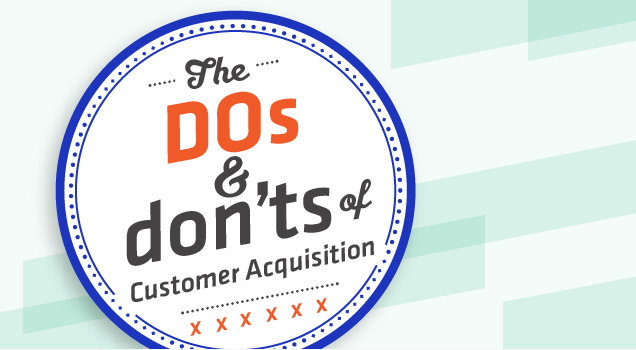Dos and Don’ts of Customer Acquisition


Everyone knows that customers are the heart and soul of a thriving enterprise. What isn’t as apparent, however, is the strategy and process required to find and acquire these customers. It may seem intuitive that if you’ve created an incredibly innovative product or service, you are guaranteed success. Or maybe you just need to throw a few young, energetic commission-only salespeople on the street to reel in the customers waiting to bang down your door…
It’s not that simple.
Customer acquisition — and particularly the investment required to successfully acquire customers — is a vital part of every organization, for-profit or not. And in the entrepreneurial space, where founders tend to be subject matter experts, not marketers, allocating adequate human and financial resources for customer acquisition is often seen as excessive and unnecessary.
Earlier this week, we sat down to chat about customer acquisition with our Brandshrink, Nancy Lerner, to pick her brain about this very subject, and she was kind enough to provide some basic dos and don’ts…to help entrepreneurs dodge these road bumps…
Regardless of how amazing a product or service is, it is absolutely essential to have an intentional strategy for acquiring customers, clients, users, members. You can’t just assume that the sheer wonderfulness of your offering is going to act like a magnetic force that attracts those willing to buy what you are selling.
If you don’t know much about customer acquisition, learn fast. Research best practices and good models, and seek out experts who are willing to help you build your strategy. Be clear about who your target audiences are and how best to reach them. Be realistic about the length of the sales cycle and the marketing tools you’ll need to help create a pipeline of prospects and bring them through the acquisition process. This is particularly important when selling into companies or institutions that have cumbersome/rigid budgetary cycles.
Consider if you need to co-opt influencers to help get to buyers, or if your product requires a change in behavior (which is usually a signal that you’ll need to provide a significant amount of education before someone will buy it). Be ready to offer trial usage, or multi-tiered pricing.
Over the years, I’ve observed that entrepreneurs are remarkably hands-on and control-freakish when it comes to the tedious details required to finesse their products and services. At the same time, they can also be remarkably aloof and distant from those they have designated as customers.
Bad idea.
If you think you know your buyers, then test your assumptions. Find them, meet them, share ideas about your new offerings and listen to their reactions. And I mean listen. That means hearing everything they have to say – good, bad and indifferent. Use what you hear to challenge assumptions about the products and services you’re building, and fine tune them to respond to the needs of those you consider your prospective customers.
One of the great ironies I’ve encountered across the entrepreneurial landscape is the tendency for founders of startups to hide their products and services because they are afraid the competition will steal their ideas. This is reflected in how often entrepreneurs take shortcuts in their branding and marketing support to keep from spilling the beans. This practice is palpable in the websites of startups…where so often they are obtuse and generic, which of course keeps poachers at bay — but also prevents potential customers from connecting.
You have to make it easy for people to get excited about what you’re selling. Don’t worry that you are at risk of having your intellectual property stolen and the proprietary value in your brand siphoned. Don’t trap demos and access to product details behind cumbersome sign-up processes that scare prospects off.
Just be straightforward and put the content out there —data, perspective, research, comparisons, and lots and lots of detail that you shape into compelling reasons for the market to believe in what you have to offer.
Today, the power of social marketing grows more critical all the time. People are more easily moved and influenced by the recommendations of others, which is one of the reasons why platforms like Yelp, Twitter and Facebook have become increasingly popular. In the old days, a company could solicit testimonials from select customers and feature these testimonials on websites and in collateral materials. Alas, this ability to control your reputation doesn’t translate to the needs of discerning buyers in today’s digital age.
With the rules of engagement between buyers and sellers changing rapidly, confident enterprises enable customers to interact directly with other customers. It’s more interesting, more real and more likely to contribute meaningfully to the expansion of your base of customers. As part of your customer acquisition strategy, you should use the tools of social media to encourage your customers to be visible and to talk with each other in one place. They can share their experiences and ideas, develop tips about what they did and write recommendations or suggestions for upgrades or enhancements.
There is tons of learning and practical knowledge about the lifetime value of a customer. Believe it and bake it into your culture and corporate manifesto. When developing your customer acquisition strategy, don’t simply look at what it takes to hook buyers, but determine what it takes to hook them — and keep them hooked — for a long, long time. In this way, you will thrive by continuing to put your customers first. Which is exactly where they belong.
Nancy Lerner is Founder and Chief Strategist for Otherwise Incorporated, and Makenzie Davies is a Social Media Marketer for Otherwise Incorporated.
Illustration credit: Josh Epstein, Designer at Otherwise Incorporated.













